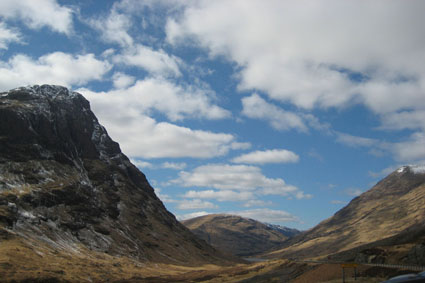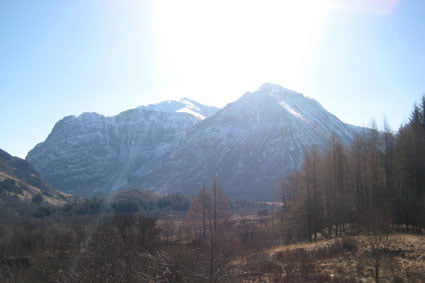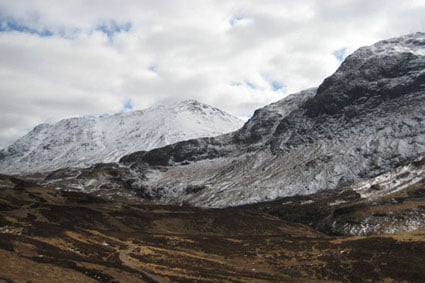We found ourselves with a tour party up in Glencoe last week, basking in the glorious spring sunshine, but with still a lot of snow around too and temperatures in single figures! The glen is located in north west Scotland, about half an hours drive from the town of Fort William. It is a simply stunning landscape in all weathers and often said to be one of the most spectacular areas of natural wilderness in Scotland.

This beautiful place was formed initially by massive volcanic eruption, around 420 million years ago. Much later, the movement of glaciers during the last Ice Age tunneled out the narrow valley, leaving impressively steep mountains on either side. The River Coe snakes through the glen, running westwards and draining into the sea loch Loch Leven at the northern end of the glen. The southern end of the glen borders Glen Etive, and flattens out into the bleak empty landscape of Rannoch Moor.
Many walkers and climbers are drawn to the glen, pulled by the sheer rugged beauty of the place and the challenge of climbing the likes of Buachaille Etive Mòr, whose Gaelic name translates as the great shepherd of Etive, (1022m) and the trio of peaks known as the Three Sisters. The long distance path, the West Highland Way, follows the old military General Wade road over Rannoch Moor into Glencoe, and then climbs the rough, steep path know as the Devil’s Staircase through the glen. There is also a ski centre. However this country is challenging even for experienced climbers, and in winter in particular conditions can be treacherous, with avalanches not uncommon.
The Massacre of 1692
Glencoe is also, sadly, well known as the site of an infamous massacre, one of the worst atrocities ever committed on British soil.
The Macdonalds of Glencoe had lived in the glen since at least the 14th century. They were fairly lawless, involved with raiding, pillaging and cattle rustling, and had a history of causing trouble for the neighborouing Clan Campbell.
Meanwhile down in London, the new King William of Orange saw the Highland clans as a unnecessary nuisance. Many of the Highland clan chiefs were supporters not of William but of the deposed Catholic King James VII. A series of Jacobite uprisings in support of James took place in the 1680s but in 1690 the Scottish Jacobites were ultimately defeated at the Battle of Cromdale in Badenoch, and James himself was defeated at the Battle of the Boyne in Ireland.
William offered the Highland clans a pardon for their part in the uprisings, ordering that they must sign an oath of allegiance to him by January 1st, 1692. He threatened them with serious reprisals if they did not comply – clans who did not sign would be punished by “the utmost extremity of the law”.
A winter storm swept through the glen on December 31st, 1691 as Alastair MacIain, the clan chief of the Macdonalds of Glencoe, made his way to Fort William to sign the oath before the governor, Colonel Hill. However here he was turned back, as the oath had to be signed before a sheriff and Hill was not authorised to accept it. This meant a 60 mile journey south to Inveraray, home of the MacIains enemies, the Clan Campbell. Hill gave MacIain a letter of protection asking the sheriff to accept his oath, since MacIain had come to him within the allotted time. It took MacIain three days to reach Inveraray, partly due to the weather and partly because he was deliberately detained for one day by Campbell soldiers serving in the Argyll regiment in an attempt to slow his progress.
Down in Edinburgh, the Secretary of State, Sir John Dalrymple, Master of Stair, was a Protestant Lowlander who disapproved of the lawless Highland way of life and was bent on destroying the clan system. In Edinburgh, Dalrymple and his advisers declined the late oath and gave strict orders – the MacDonalds were to be “cut off root and branch….to put all to the sword under seventy“.

Captain Robert Campbell of Glen Lyon led the 120 or so government troops to Glencoe. The men were billeted and received as friends into the homes of the MacDonalds, as was common place according to custom in the Highlands at the time. The soldiers enjoyed the hospitality of the MacDonalds for twelve days. Then, as their hosts slept, the order was given to attack. MacIain was slain as he rose from his bed, and in total 38 clansmen were murdered in their beds or as they tried to flee. Homes were burned, and many more, including women and children, died from exposure on the mountainside.
That so many survived (the clan numbered around 200) may well be due to the fact that many of the soldiers simply did not have the stomach for the fight. It is almost certain that some Campbell soldiers, disgusted by their orders, gave warning to their host families, allowing them a chance to escape. Some historians also believe the late arrival of two detachments of soldiers, both of some 400 men, who were due to take part in the slaughter was deliberate. Undoubtedly they would have been held up by the horrendous weather conditions in the glen but it may be that many simply did not wish to take part in such a heinous crime.
News of the events quickly spread, and the Scottish people were outraged by the cold blooded nature of the massacre of the clansmen. A public enquiry was held in Edinburgh and the affair was declared an act of murder. The King was exonerated but John Dalrymple, the Master of Stair, was held responsible for the slaughter. He resigned his position but was never brought to trial. The affair was subsequently forgotten by the government.
In Scotland however, the massacre passed into legend and became a propaganda piece for the Jacobite movement. Today in Glencoe there is a memorial stone to the fallen clansmen, and to this day a sign at the reception desk of the old Clachaig Inn at Glencoe reads “no hawkers or Campbells“.

Visiting Glencoe today
The glen is, thankfully, a much more peaceful place today. Most of the area is now in the care of the National Trust for Scotland, and you can visit the excellent Glencoe Visitor Centre just south of Glencoe village, which tells the story of life in the glen through the ages as well as the history of the massacre.
If you’d love to see the beauty of Glencoe for yourself as part of a Scotland tour, drop us a line and we can suggest some touring routes as part of your Scotland vacation package.
Related posts
Serious wildfires in the north east: Several roads are closed in the Moray area and a call has gone out for volunteers to assist the Fire Service.
Roads closed as fire crews spend second night at Highland wildfires
The alarm was raised in woodland near Loch Allan and spread over an area of several miles.
A few adjustments being made to the planting at the floral clock today 🕰️🌸🌻 Edinburgh’s floral clock is the oldest in the world, first planted in 1903 by Parks Superintendent John McHattie. The cuckoo clock was added later in the 1950s. Every year the parks department does an amazing job See More
Scorchio at Portobello today ☀️☀️☀️ #scotland #scotlandlover #scotlandexplore #scotlandshots #scotlandisnow #scotlandtravel #beachdog #beachday #edinburghbeach #edinburgh #portobello #portobellobeach See More





